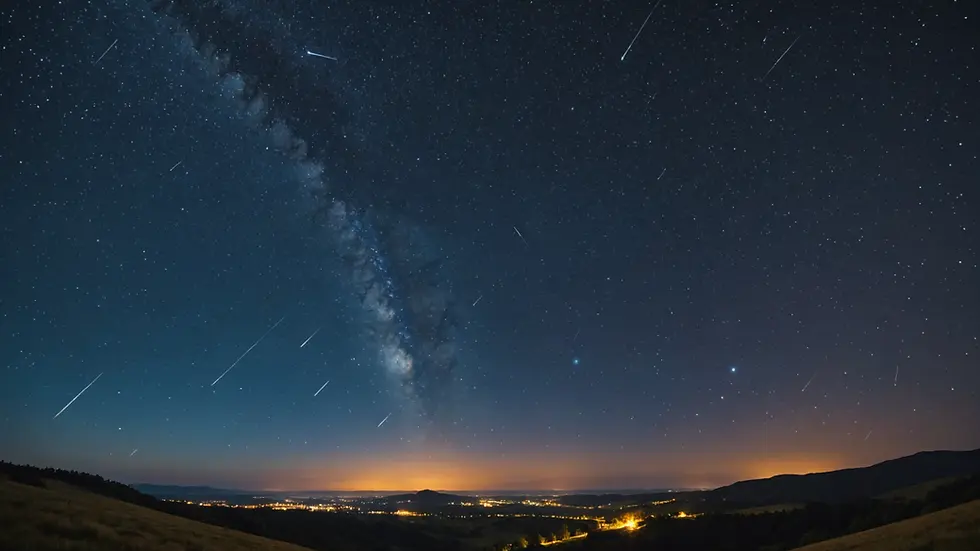Uncovering the Magic: A Beginner's Guide to Photographing Meteor Showers
- BoldCreations ByTJ
- Feb 8
- 3 min read
Bold Creations by TJ 2/8/2025
Capturing the fleeting beauty of meteor showers is a thrilling endeavor for any photography fan. The excitement of witnessing Nature’s fireworks while attempting to freeze that moment in time presents a unique blend of creativity and technical skill. These brilliant streaks of light, as they scatter across the night sky, inspire awe and leave a lasting impression. If you are eager to explore the captivating world of astrophotography and learn how to photograph meteor showers, this guide is tailored just for you.
Understanding Meteor Showers
Meteor showers happen when Earth travels through debris trails left by comets or asteroids. During particular times each year, tiny particles collide with our atmosphere, burning brightly and creating spectacular displays in the sky. Some famous meteor showers include the Perseids in August, which can produce up to 100 meteors per hour under ideal conditions, and the Geminids in December, known for their colorful displays and high visibility.
To capture these celestial wonders, invest time in researching their schedules and identifying optimal viewing spots with low light pollution. Websites like the American Meteor Society provide calendars and detailed information about peak viewing times. For example, the peak of the Geminids typically occurs around December 13-14, making it an excellent opportunity to plan your photography session.
Equipment You’ll Need
Using the right gear is crucial for photographing meteor showers. Here’s a focused checklist to help you prepare:
Camera: Choose a DSLR or mirrorless camera that allows for manual settings.
Lens: A wide-angle lens (18mm or wider) is ideal for capturing expansive views of the night sky.
Tripod: A sturdy tripod is essential for stabilizing your camera during long exposures, helping you avoid blurry images.
Remote Shutter Release: This accessory minimizes camera shake and allows for smoother shooting.
In addition to the essentials, consider bringing a flashlight with red light to maintain your night vision. Pack extra batteries and a high-capacity memory card—aim for at least 64GB to ensure you won't miss capturing a single moment. Being well-equipped will help you concentrate on capturing the magic above.
Setting Up Your Shot
Finding the right spot to shoot meteor showers is just as important as your gear. Seek out locations that are away from city lights, such as open parks or elevated hills. Arrive early during twilight to adjust your settings and get everything in place before the meteors start to appear.
For camera settings, use a low f-stop (like f/2.8) and a higher ISO (around 1600 or higher) to capture more light. Set your exposure time between 15-30 seconds, and be prepared to make adjustments as conditions change. Incorporate a wide open horizon in your composition to frame both the meteor activity and the stunning landscape below, increasing the drama and context of your photos.

Chasing the Perfect Meteor
Once you find your spot, patience becomes your best friend. Meteor showers can be unpredictable, and part of the thrill is the wait. Keep your camera focused on a fixed location to capture multiple meteors over time.
A great technique is to take a series of long exposure images and stack them during post-processing. Programs like Adobe Photoshop can help combine images to enhance and highlight the visibility of shooting stars. This method not only increases the number of meteors in your final image but also improves the overall clarity. With practice, you can transform these fleeting moments into striking pieces of art that capture the allure of the night sky.
Capturing the Night Sky
Photographing meteor showers is an engaging adventure that combines the magnificence of the cosmos with the skill of photography. By preparing effectively, understanding your gear, and exercising patience, you can create breathtaking images that showcase the beauty of these celestial phenomena.
So gather your equipment, venture into the great outdoors, and embrace the magic of falling stars. Each photograph carries a story, and over time, you will discover your unique artistic style shining through the night sky. With each shooting star, let your creativity soar.









Comments